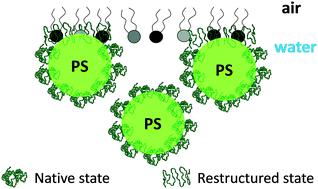当前位置:
X-MOL 学术
›
Environ. Sci.: Nano
›
论文详情
Our official English website, www.x-mol.net, welcomes your feedback! (Note: you will need to create a separate account there.)
Albumin protein coronas render nanoparticles surface active: consonant interactions at air–water and at lipid monolayer interfaces
Environmental Science: Nano ( IF 7.3 ) Pub Date : 2021-1-4 , DOI: 10.1039/d0en00934b Nasim Ganji 1, 2, 3, 4 , Geoffrey D. Bothun 1, 2, 3, 4
Environmental Science: Nano ( IF 7.3 ) Pub Date : 2021-1-4 , DOI: 10.1039/d0en00934b Nasim Ganji 1, 2, 3, 4 , Geoffrey D. Bothun 1, 2, 3, 4
Affiliation

|
Protein coronas are known to alter the physicochemical properties, colloidal stability, and biological fate of nanoparticles. Using human serum albumin (HSA) and polystyrene nanoparticles (NPs) with anionic or cationic surface chemistries, we show that protein coronas also govern the surface activity of PS nanoparticles as well as their interactions with a model red blood cell (RBC) lipid monolayer. The adsorption kinetics of bare nanoparticles (no corona) and nanoparticles with a hard corona (HC) at an air–water interface were well-described theoretically, which revealed that the adsorption energy was greater with the corona due to hydrophobic interactions that were enhanced with protein restructuring. Corona complexation increased the concentration of nanoparticles at the interface and led to the formation of interfacial aggregates. Despite clear differences in monolayer structure, the compressibility of PS–HC monolayers was similar to free HSA, indicating that conformational changes associated with the protein were not restricted in a hard corona. The intrinsic behavior of the proteins driving the surface activity and compressibility of the complexes at an air–water interface was also observed at an air–lipid (RBC)–water interface. In this case the lipid monolayer acted as a barrier and reduced the interface concentration of bare nanoparticles. However, with a corona the nanoparticles penetrated into the monolayer and led to the formation of NP–HC–lipid ‘pillars’ that extended into air. Our results suggest that nanoparticle surface activity, and changes in surface activity due to corona formation, are insightful parameters to predicting nanoparticle–membrane interactions, complementing the conventional view that electrostatic forces are dominant.
中文翻译:

白蛋白蛋白电晕使纳米颗粒表面活跃:空气-水和脂质单层界面的辅音相互作用
已知蛋白电晕会改变纳米粒子的物理化学性质,胶体稳定性和生物命运。使用具有阴离子或阳离子表面化学作用的人血清白蛋白(HSA)和聚苯乙烯纳米颗粒(NPs),我们显示蛋白质电晕还控制PS纳米颗粒的表面活性以及它们与模型红细胞(RBC)脂质单层的相互作用。理论上很好地描述了裸露的纳米粒子(无电晕)和在空气-水界面处具有硬电晕(HC)的纳米粒子的吸附动力学,这表明由于疏水性相互作用增强了电晕,因此吸附能更大。蛋白质重组。电晕络合增加了界面处纳米颗粒的浓度,并导致界面聚集体的形成。尽管单层结构存在明显差异,但PS-HC单层的可压缩性与游离HSA相似,这表明与蛋白质相关的构象变化在硬电晕中不受限制。在空气-脂质(RBC)-水界面处还观察到了蛋白质的固有行为,这些蛋白质在空气-水界面处驱动了复合物的表面活性和可压缩性。在这种情况下,脂质单层充当屏障并降低了裸露的纳米颗粒的界面浓度。然而,使用电晕,纳米颗粒会渗入单层并导致形成NP–HC–脂质“柱”,并延伸到空气中。我们的结果表明,纳米颗粒的表面活性以及由于电晕形成而引起的表面活性的变化,是预测纳米颗粒与膜之间相互作用的有见地的参数,
更新日期:2021-01-04
中文翻译:

白蛋白蛋白电晕使纳米颗粒表面活跃:空气-水和脂质单层界面的辅音相互作用
已知蛋白电晕会改变纳米粒子的物理化学性质,胶体稳定性和生物命运。使用具有阴离子或阳离子表面化学作用的人血清白蛋白(HSA)和聚苯乙烯纳米颗粒(NPs),我们显示蛋白质电晕还控制PS纳米颗粒的表面活性以及它们与模型红细胞(RBC)脂质单层的相互作用。理论上很好地描述了裸露的纳米粒子(无电晕)和在空气-水界面处具有硬电晕(HC)的纳米粒子的吸附动力学,这表明由于疏水性相互作用增强了电晕,因此吸附能更大。蛋白质重组。电晕络合增加了界面处纳米颗粒的浓度,并导致界面聚集体的形成。尽管单层结构存在明显差异,但PS-HC单层的可压缩性与游离HSA相似,这表明与蛋白质相关的构象变化在硬电晕中不受限制。在空气-脂质(RBC)-水界面处还观察到了蛋白质的固有行为,这些蛋白质在空气-水界面处驱动了复合物的表面活性和可压缩性。在这种情况下,脂质单层充当屏障并降低了裸露的纳米颗粒的界面浓度。然而,使用电晕,纳米颗粒会渗入单层并导致形成NP–HC–脂质“柱”,并延伸到空气中。我们的结果表明,纳米颗粒的表面活性以及由于电晕形成而引起的表面活性的变化,是预测纳米颗粒与膜之间相互作用的有见地的参数,



























 京公网安备 11010802027423号
京公网安备 11010802027423号